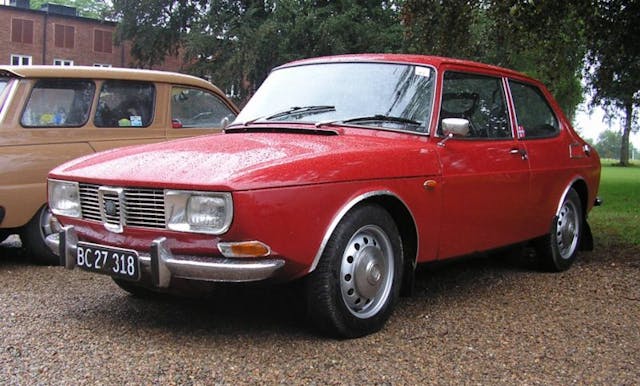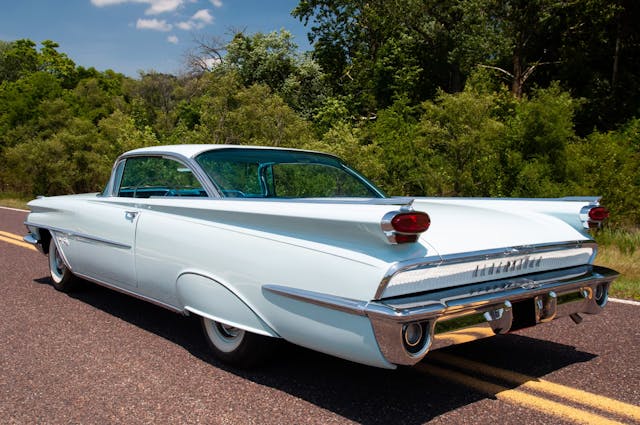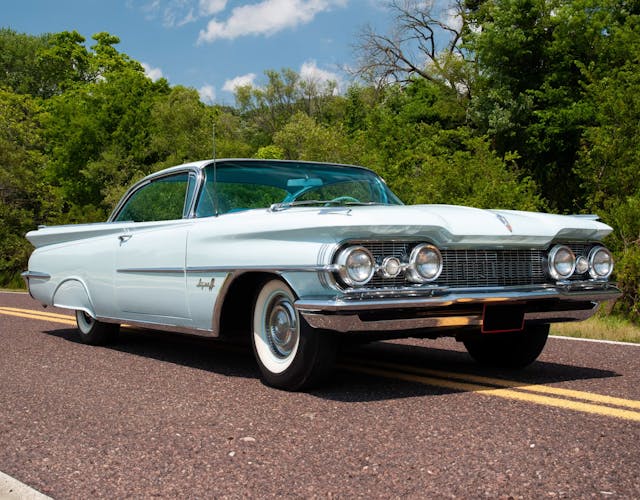5 Cars Posting the Biggest Gains in a Slow Market
The enthusiast car market has been slowing since the summer of 2022, but it’s also a vast market that doesn’t behave uniformly. Some cars have stopped appreciating or are now contracting in value; others continue to realize gains. Here are five of the cars that increased the most in value in the latest installment of the Hagerty Price Guide, which was published online on January 1st. The group is eclectic, to say the least, which is partly due to the pricing volatility for low-volume cars, as well as a reflection that the market for most “known” cars is much quieter than it was to start 2022. (Read more to learn about the methodology behind Hagerty Price Guide.)
1970-1972 Nissan Fairlady Z 432 +48%

Most American car enthusiasts know the Datsun 240Z, but far fewer know the Nissan Fairlady Z 432. That lack of awareness hasn’t hindered values, though. The car surged in price by 48 percent to close the year, and one in excellent condition now costs a hair below $300,000.
The Z 432 is a performance variant of the original Z car produced for the Japanese domestic market, and features a close-ratio five-speed transmission, dual exhaust, a limited-slip rear differential, and a sportier suspension. Most importantly, though, it is powered by the same four-valve, three-carb, dual-overhead cam S20 engine that propelled the legendary Prince R380, Japan’s first purpose-built prototype racer. The 432 is exceedingly rare, too, with only around 420 built.
Given their rarity and the devotion of their owners, these cars change hands infrequently, but an excellent example found a new owner at Mecum’s Monterey auction last August for $297,000. This public benchmark is consistent with reported private sales activity for perfect cars soaring above $400,000. Furthermore, the Nissan “Hakosuka” Skyline 2000GT-R also had a strong quarter, with their price guide values increasing by 13 percent. These are proof that JDM fans are as interested in the older back catalog as they are in more modern models.
1968-1984 Saab 99 +30%

Historically, Saab’s unconventional styling and unusual technology limited the brand’s mass appeal in the U.S., but those same traits are what have earned the cars a loyal American fan base today. Loyal enough, in fact, that the Saab 900 Turbo landed on our 2023 Bull Market list.
The 99 preceded the 900 by a decade and was Saab’s first upmarket foray. Larger (though not outright large) and more luxurious than prior Saab models like the 93 and 96, the 99 brought the company a step closer to the mainstream. Gone were the company’s two-stroke engines, replaced with a two-liter inline-four sourced from Triumph, that could come equipped with a then-novel turbocharger. The 99 had a reputation for impressive build quality and had an abundance of trims available, including the sportier EMS. It was a massive sales success for the Swedish company and established the tone for Saab’s product line in the 1980s and 1990s.
In this update of the Hagerty Price Guide, the 99 Turbo and EMS versions increased by a stout 30 percent, pushing values of the Turbo models up to $21,600 for an excellent example. The EMS, meanwhile, now sits at $16,200 in the same condition. Apparently interest in the Saab 900 is carrying over to its older sibling.
1963-1969 Alpine GT4 +24%

If an Alpine A110 is too mainstream for you, consider the GT4, Alpine’s four-seat take on the diminutive French giant killer. The GT4’s tall roofline makes it clear the car is a hopped-up people hauler and not a purpose-built race car, and it justifiably trades at a discount to the A110. It’s also one of the rarer cars we include in the Hagerty Price Guide, with fewer than 300 produced, making it one of the more challenging cars in our guide to value. That said, Artcurial sold a needy example over the summer with a mid-estimate result that allowed us to dial in pricing, which is now at $32,500 for an excellent car. If you’re keeping score, the six-figure A110, a different animal altogether, saw its values drop by two percent over the same period.
1959-1960 Oldsmobile 88 / 98 Holiday Coupe +24%

The 1959 model year introduced a more modern, “Linear Look” to Oldsmobile’s 88 and 98 line-ups, with the Holiday Coupes being the sleekest and airiest of all. This iteration only lasted two model years and served as a transition between the stylistic exuberance of the 1950s and the Jet-Age refinement of the early 1960s. Due to its short lifespan and its position as a liminal design, this era of Oldsmobile is often overlooked, and its value story underscores that—pricing was essentially unchanged from the start of 2019 to mid-2023.
That wasn’t the case at the end of last year, however, as several public sales confirmed that buyers are now paying higher prices. Rather than a sign of an impending boom for this era of GM full-size coupes, this is more likely an aftershock of the pandemic surge, with the Olds starting to catch up to where other contemporaries have already gone.
1962-1969 Abarth 1000 +24%

In the 1950s and 1960s, Carlo Abarth’s eponymous company found fame by manufacturing go-fast parts for Fiats and eventually tuning Fiat models for motorsports use. Abarth even transformed Fiat’s cute and cuddly 600 economy car into the pugnacious 1000 Berlina and 1000 TC racers for competition in Group 2 and Group 5 touring car races. A front-mounted radiator, bored-out engine, and hemispherical combustion chambers, among numerous other tweaks, changed the car’s nature entirely and resulted in much success in European events.
The market for this car had been relatively sleepy since January 2021, but sale and advertised prices for these models have been increasing consistently enough to prompt us to push values higher. Authenticity is always a question for these cars, but even at their new levels of $30,000 for the Berlina and $47,700 for the TC (both in “excellent” condition), they seem like a ton of fun for the money.
***
Check out the Hagerty Media homepage so you don’t miss a single story, or better yet, bookmark it. To get our best stories delivered right to your inbox, subscribe to our newsletters.



Non of them catch my eye except the Olds. Reminds me of one my uncle had. I was too young to know much but it had a monstrous engine in it. He eventually put it in an old pickup truck he used to deliver feed. Got stopped by a cop after a major burnout. He was going to use the line that “you don’t think an old truck like this could do that”. Didn’t work…the tires were still smoking.
I really am turned off by discussions based on the investment values like stock market traders. As we boomers die off, our cars will really depress the market as our families compete to unload our treasures before they tank the market. Sorry, not sorry.
I’m going for a drive (‘71 MGB).
Everything previously neglected is moving up some, or a lot. Simply put, a GTO or Camaro or traditional collectible is not cheap, so a well preserved Olds or Buick, or something else is a bargain at $25k or below, hence the run up in 4 doors. The adage “you can’t do a car for that”, is better understood now, so these somewhat “off-market” cars are now better understood for the value they are. I’m sure that ’59 Olds is a bargain compared to its equivalent Impala.
I still remember as a kid when the Datsun 240Z came out, followed by the 260Z. What a complete tin can it was. Still back in the day when the stamp “Made in Japan” was as bad or worse than what “Made in China” signals today. The turtle neck sweater crowd was buying in on those things when American muscle cars were having their heyday but known for gutless performance, troublesome power plants, cheap interior parts, and doors that sounded like, “BONK” when you shut them with any force, which is saying something, since American auto manufacturing was not exactly at the zenith of industry quality at the time. I get that the Fairlady receives a nod because she’s aged appropriately and had a race-bred engine, but having lived through the years when there was a dead 240Z parked in every other neighborhood and running units sold for a few hundred dollars, I really struggle with the thought of these cars being $300k desirable.
It is good to see certain SAAB 99 models – those with the venerable SAAB-built 2 liter engines – gaining in market value just as the older style SAAB 95 wagons (in the picture above with the 99) and the 96 sedans have experienced over the last ten years. A well cared for earlier 99 is particularly rare such as the chrome bumpered ~1970 European model in the picture above. There are perhaps less than 30 of those pre 1972 models remaining in the US. 99s are such an enjoyable car to drive with comfortable seats putting one in a great driving position. The 99 models started the SAAB tradition of putting the ignition key in the center console for safety reasons. I will continue to own a 99 for many years to come and luckily have parts to spare.
In the late 60s I was stationed at Coast Guard Air Station San Juan & had a rusty 59 Olds. When transferred I parked the Olds at the international airport & flew back state side. I guess its still in the parking lot.
It is being used daily has a taxi.
Fewer than 300 produced, l’ve sometimes wondered who your audience is, I guess that confirms it. Give me that gorgeous Olds
What’s a one-owner (me) running 1968 coup numbers-match 427-390hp with original eng/interior worth? Orig wp, alt, starter, air pump.
I really enjoyed my brief ownership of a 61″ Olds. Sadly, no AC but a great car.
Why are you spending so much of your ( and therfore My ) time doing a Value Increase Report on cars that virtually dont exist in the North American Mainstream Sales Market? PLEASE return back to the roots of collectable cars that basic Americans might be able to find, and more importantly, afford to purchase!!
Yeah, & American cars to boot, rather than some obscure foreign car that most of us have never seen in daily use.
I agree. Let’s get back to the AMERICAN muscle that started it all. I do understand that Haggerty, as an insurance marketplace has to do other cars to, but I’m an American born here in the great U.S.A… and I was raised on the older (at that time new) cars. Yes my Dad had a 1959 Oldsmobile Dynamic 88 convertible that I learned to drive on. GREAT CAR.
Right on Glenn!!
Here we go again, four foreign cars, one American car! C’mon man!
Other than the Oldsmobile, hopefully without the hideous fender skirts, I find absolutely nothing about the remaining cars that would justify their supposed popularity or value. The whole concept of a $400,000 Datsun boggles the mind. For that kind of money you could buy several REALLY nice cars……and have enough left to hire someone to take the Datsun to the crusher.
To your point Uncle+Doug, I have shown cars & have attended many many car shows in affluent areas on Long Island NY. And the number of foreign cars, much less what’s on this list is miniscule. Get real Hagerty, & list cars that really mean something to the mainstream market.
Understand that different people like different things. I wouldn’t buy any of these cars, but I still appreciate them as interesting. Certainly more interesting than a modern SUV
HemiBob hit the nail on the head and a few others too who commented that people pay up for something they have a liking for. Funny that ‘dub6’ hasn’t chimed as I would normally expect??
I always wanted to do a mid V8 2nd gen Corvair, but now it seems a shame to cut up such a unique piece of GM history. The Crown Engineering kit seems to be the best, but I haven’t seen one for sale in years. 😥
A guy at the community college next to my childhood home had a 1st gen Corvair with a Ford 460 in the backseat. It was an amazing piece of redneck engineering
Nice to see “Some” change— the last few yrs at car shows have been seeing the same old same old cars—Hardly anything Different–